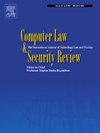Navigating the intersection: How antitrust law can facilitate fair standard essential patent licensing in China
IF 3.3
3区 社会学
Q1 LAW
引用次数: 0
Abstract
The integration of high-quality communication patents into technical standards has intensified competition and raised antitrust concerns in Standard Essential Patent (SEP) licensing. This paper examines China’s antitrust regulation of SEP licensing amid rapid market development and increasing alignment with international practices. Since entering the world stage, China has gone through an initial exploration phase (1992–2012), framework construction phase (2013–2019), and now the rules refinement phase (2020–). The antitrust enforcement rules regulating SEP licensing have become relatively clear. In particular, on November 8, 2024, the Anti-monopoly Guidelines for Standard Essential Patents issued by China’s State Administration for Market Regulation further refined the antitrust enforcement rules in the SEP licensing field. However, China’s antitrust regulation of SEP licensing faces significant challenges despite recent regulatory developments. This paper examines three critical issues: determining market dominance of SEP holders, assessing monopolistic behavior in injunctive relief requests, and establishing benchmarks for excessive or discriminatory pricing. Drawing from US and Europe enforcement experiences while considering China’s context, this study advocates for Chinese enforcement agencies to: (1) prioritize effect-based analysis when establishing SEP holders’ market dominance by examining standard irreplaceability and patent essentiality; (2) refine the criteria for determining whether rights holders have demonstrated clear misconduct when assessing the antitrust implications of injunctive relief requests, and consider these alongside other contextual factors; (3) maintain a clear distinction between excessive pricing and discriminatory pricing when assessing potential FRAND violations. Regarding excessive pricing allegations, antitrust intervention should proceed with caution on a case-by-case basis, integrating multiple factors to determine whether royalty rates significantly and persistently exceed benchmark rates. For discriminatory pricing concerns, authorities must evaluate whether pricing differentials in comparable SEP transactions generate competitive harm; (4) maintain cautious enforcement approaches that balance private and public interests. These recommendations aim to enhance antitrust effectiveness in promoting fair competition and innovation while contributing to a more equitable international patent system.
在交叉路口导航:反垄断法如何促进中国的公平标准基本专利许可
将高质量的通信专利整合到技术标准中,加剧了标准必要专利(SEP)许可方面的竞争,并引发了反垄断担忧。本文考察了在市场快速发展和日益与国际惯例接轨的背景下,中国对SEP许可的反垄断监管。自进入世界舞台以来,中国经历了初步探索阶段(1992-2012年)、框架构建阶段(2013-2019年)和规则细化阶段(2020 -年)。规范SEP许可的反垄断执法规则已经相对清晰。特别是,中国国家市场监督管理总局于2024年11月8日发布的《标准必要专利反垄断指南》进一步细化了SEP许可领域的反垄断执法规则。然而,尽管最近的监管发展,中国对SEP许可的反垄断监管面临着重大挑战。本文探讨了三个关键问题:确定SEP持有人的市场支配地位,评估禁令救济请求中的垄断行为,以及建立过度或歧视性定价的基准。借鉴欧美执法经验,结合中国国情,建议中国执法机构:(1)通过考察标准不可替代性和专利必要性,在确立SEP权利人的市场支配地位时,优先考虑基于效果的分析;(2)在评估禁令救济请求的反垄断影响时,完善确定权利人是否表现出明显不当行为的标准,并将这些标准与其他背景因素一并考虑;(3)在评估潜在的FRAND违规行为时,明确区分过度定价和歧视性定价。关于定价过高的指控,反垄断干预应在个案的基础上谨慎进行,综合多种因素,以确定特许权使用费费率是否显著和持续超过基准费率。对于歧视性定价问题,当局必须评估可比SEP交易中的定价差异是否会造成竞争损害;(4)保持谨慎的执法方式,平衡私人和公共利益。这些建议旨在提高反垄断在促进公平竞争和创新方面的有效性,同时为更公平的国际专利制度作出贡献。
本文章由计算机程序翻译,如有差异,请以英文原文为准。
求助全文
约1分钟内获得全文
求助全文
来源期刊
CiteScore
5.60
自引率
10.30%
发文量
81
审稿时长
67 days
期刊介绍:
CLSR publishes refereed academic and practitioner papers on topics such as Web 2.0, IT security, Identity management, ID cards, RFID, interference with privacy, Internet law, telecoms regulation, online broadcasting, intellectual property, software law, e-commerce, outsourcing, data protection, EU policy, freedom of information, computer security and many other topics. In addition it provides a regular update on European Union developments, national news from more than 20 jurisdictions in both Europe and the Pacific Rim. It is looking for papers within the subject area that display good quality legal analysis and new lines of legal thought or policy development that go beyond mere description of the subject area, however accurate that may be.

 求助内容:
求助内容: 应助结果提醒方式:
应助结果提醒方式:


